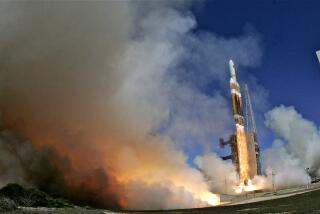China downplays U.S. bomber flight in disputed airspace
- Share via
BEIJING -- China on Wednesday played down a U.S. challenge to its newly created air defense zone in the East China Sea, saying two American B-52 bombers that transited the area “were monitored the whole time and identified.”
“China has the ability to implement effective control over the airspace,” Geng Yansheng, a Defense Ministry spokesman, told reporters.
Tuesday’s flight of the B-52s over a disputed island chain rattled the Chinese military, openly flouting the rules of the new air defense zone, in which planes are required to give Chinese officials advance notice of flight plans over the area.
The zone China has claimed covers part of the airspace over a group of islands known as the Diaoyu in China and Senkaku in Japan. Both countries claim the islands, which Japan administers. China announced Saturday that it would require anyone flying into the zone to file a flight plan and submit radio frequency or transponder information.
In open defiance of Beijing, the U.S. aircraft flew out of Guam and entered the new “East China Sea Air Defense Identification Zone,” Pentagon officials said Tuesday. China made no response, they said. The Air Force bases B-52 bombers in Guam, but Pentagon officials would not comment on the type of bomber used in the overflight.
“As part of a long-planned training mission, two unarmed military aircraft transited airspace near the Senkaku islands,” Air Force Lt. Col. Tom Crosson, a Pentagon spokesman, said in an email. “The training sortie was uneventful. This training sortie was part of our continued bomber presence in the region.”
Before the flights, a Pentagon spokesman told reporters that the military would not comply with China’s demands while flying over what the U.S. considers international waters and airspace.
“The U.S. military will continue conducting flight operations in the region, including with our allies and partners, and will not in any way change how we conduct our operations as a result of this new policy,” Army Col. Steve Warren said.
“We will not register a flight plan, we will not identify our transponder, our radio frequency and logo,” he said.
Japanese commercial airlines, which initially promised to give their flight plans in advance to China, reversed their decision on Wednesday on instruction from their government, which said informing the Chinese would be tantamount to accepting the new zone.
Air Nippon Airways and Japan Airlines flew passenger jets Wednesday from Japan to Taipei, passing through the zone.
Paul Haenle, director of the Carnegie-Tsinghua Center for Global Policy in Beijing, said the situation brings to mind the 2001 midair collision between a U.S. EP-3 intelligence plane and a Chinese fighter plane, in which a pilot was killed.
“If you have a collision between a Japanese and a Chinese aircraft and somebody dies, it will be very difficult to manage it and work through the crisis the way we did in 2001,” Haenle said. “This is a very precarious time for the East China Sea.”
A Chinese expert on Japan, who asked not to be quoted by name, said he also worried about miscalculations.
“If you look back at history, so many wars started by accident,” said the Chinese scholar.
More than 20 countries have similar air defense identification zones, including Japan and the United States, but China’s has provoked widespread condemnation because it includes territory it does not currently control.
Beijing’s new air defense zone has also infuriated the South Koreans because it includes an underwater reef called Ieodo administered by Seoul.
White House spokesman Josh Earnest said Tuesday that the Chinese announcement was “unnecessarily inflammatory” and had a “destabilizing impact on the region.”
Separately, China on Tuesday sent its first aircraft carrier on its first open-sea training mission in the South China Sea, where Beijing also has territorial disputes with its neighbors.
The Liaoning is a retrofitted Russia-made carrier that is seen as emblematic of China’s growing naval ambitions. Chinese state media described the trip as a routine “scientific and training mission.”
ALSO:
U.S. looks to bypass Karzai on Afghanistan security deal
Israeli security forces kill three Palestinians in West Bank
Mexico teen cartel member ‘El Ponchis’ released, headed to U.S.
Twitter: @BarbaraDemick, @KenDilanianLAT
More to Read
Sign up for Essential California
The most important California stories and recommendations in your inbox every morning.
You may occasionally receive promotional content from the Los Angeles Times.













